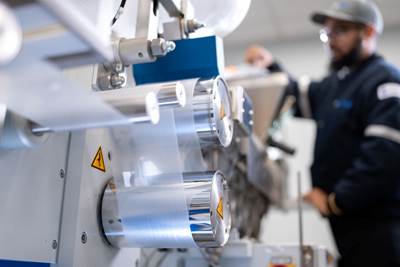Stripping Anodic Coating
Question: What is the best way to strip an anodize coating?
Share
Read Next
Question:
What is the best way to strip an anodize coating? Is it possible to use a zincate, as I have heard some people do? L.H.
Answer:
There are many ways to strip the anodic coating from the aluminum substrate. Two or three come to mind in particular and it depends on the situation as to which method is “best”.
The most common method of stripping used in production anodizing lines uses a bath of caustic soda (sodium hydroxide) and water. The concentration of caustic is generally 2-10% of 50% liquid caustic soda by volume in water. (Note: liquid caustic soda is sold in its concentrated form as 50% liquid caustic. In other words, the most concentrated solution you can readily purchase is a mixture of 50% water and 50% sodium oxide.) A temperature of 120-150F using plenty of air agitation is the usual procedure. The anodic coating will strip in a few seconds to a few minutes depending on the bath concentration and temperature, the anodize coating thickness and the degree of seal of the coating. For some well sealed, heavier coatings an acid soak, such as in the desmutting bath, of up to 30 minutes in duration prior to stripping will usually ensure that the coating comes off uniformly. There is more to the caustic bath chemistry than meets the eye. I will only mention in passing that the bath should include additives that contain various sequestering and chelating agents to help keep the dissolved aluminum in suspension. This is crucial because if the aluminum were to build up to the point where, without these additives, the bath could no longer hold it in suspension, a rock-hard hydrate of aluminum would form in the tank and render it inoperable. Any more detail than this about the bath operation involves a lengthy explanation and is beyond the scope of your question.
Another method of stripping the anodic coating uses various combinations of sulfuric acid and chromic acid at about 130-140F. This chemistry will readily remove the anodic coating but will not remove aluminum in the process, as caustic soda does. This was a popular stripper and desmutter in anodizing lines until about 1970 when environmental concerns about chromates began to take hold. The common chemistry for this bath is 175-g/liter chromic acid plus 35-g/liter sulfuric acid in water.
Another stripping solution that removes only the oxide coating can be found as part of ASTM B 680-80(1989), the Acid Dissolution Test. This method uses 20 g of chromic acid anhydride and 35 ml of orthophosphoric acid (85% mass) in distilled or deionized water to make one liter of solution. This procedure is only used in the laboratory to measure both coating weight and to assess the quality of seal.
I do not have any experience using a zincate bath as a stripper for the anodize coating and I was unable to locate anyone who has. Zincate is used as a pretreatment for electroless nickel plating on aluminum. I would not recommend it for stripping the anodize coating from aluminum.
Related Content
Plasma Electrolytic Oxidation (PEO): A High-Performance Coating for Light Metal Alloys
Plasma Electrolytic Oxidation (PEO) offers an innovative approach to high-performance coatings for light metal alloys, providing superior alternatives to traditional hard anodizing. The process transforms the surface of metals like Al, Mg and Ti into a robust oxide layer with customizable properties, tailored for demanding applications in aerospace, semiconductor, and industrial manufacturing.
Read MoreSurface Treatment Breakthroughs for Recycled, New Aluminum Alloys
Recycled alloys and surface treatments like anodizing are driving durability and eco-friendly innovation in modern applications.
Read MoreTop Shop Aims to Reshape Aerospace Finishing in Florida
By blending legacy finishing expertise with new heat treat and painting operations, Incertec is taking off in a fast-growing aerospace market. Business acquisitions have boosted its emergence onto a path to success.
Read MoreSelecting high-capacity anodizing tanks
Process tanks are the foundation of finishing. Asa Halliday of Tri-Mer Corp. discusses considerations to keep in mind when selecting anodizing tanks.
Read MoreRead Next
The Best Tape for High-Temperature Applications
High-temperature tapes are designed with maximum heat ratings indicating the highest temperature they can withstand for a very short time.
Read MoreDelivering Increased Benefits to Greenhouse Films
Baystar's Borstar technology is helping customers deliver better, more reliable production methods to greenhouse agriculture.
Read More




















